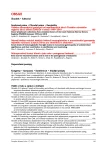Donor lymphocyte collections from unrelated donors of the Czech National Marrow Donors Registry (ČNMDR) between 1999 and 2010
Authors:
D. Lysák 1; M. Hrabětová 1; A. Jungová 1; T. Svoboda 1; Navrátilová J.1ihash2 ,2 ,2
Authors‘ workplace:
Hematologicko-onkologické oddělení FN Plzeň, Český národní registr dárců dřeně
1
Published in:
Transfuze Hematol. dnes,17, 2011, No. 4, p. 165-170.
Category:
Comprehensive Reports, Original Papers, Case Reports
Overview
We analyzed a group of 45 unrelated donors who had donated donor lymphocytes in the collection centre of the Czech National Marrow Donor Registry between 1999 and 2010. An upward trend was apparent in the past 3 years for the evolution of collection numbers in time. Lymphocyte collection was requested primarily for patients with acute leukaemia, chronic myeloid leukaemia and non-Hodgkin lymphoma (44%, 18% and 16% of all donations). Immunotherapy using donor lymphocytes was most frequently indicated for haematological or molecular relapse (57% and 16%) or persisting mixed chimerism after transplantation (16 % of donations). Lymphocyte collection was undertaken at a median of 8.4 (1.3–6) months following the initial collection of bone marrow or peripheral blood stem cells. The collected number corresponded to 0.9 (0.1–5.0) x 108 CD3+ cells per kilogram of recipient weight. A repeated lymphocyte donation was requested only for one recipient. The number of CD3+ cells in the product correlated with the leukocyte count (r=0,427, p=0.0031) and mononuclear cell numbers in donor peripheral blood before donation (r=0.511, p=0.0003). Adverse events during the donation occurred in only 9 % of donors and in all cases were clinically insignificant. Donor lymphocyte donation is a safe and minimally taxing method of donation. Immunotherapy using donor lymphocytes enables the treatment of many complications following allogeneic haematopoietic stem cells transplantation. With the development of non-myeloablative conditioning regimens and an increased understanding of post-transplant immunological interactions etc., it may be presumed that there will be an increasing demand for lymphocyte donations from the original donors in the years to come.
Key words:
donor lymphocyte, GVL, adverse reaction, donors
Sources
1. Tomblyn M, Lazarus HM. Donor lymphocyte infusions: the long and winding road: how should it be traveled? Bone Marrow Transplant 2008; 42: 569-579.
2. Marks DI, Lush R, Cavenagh J, et al. The toxicity and efficacy of donor lymphocyte infusions given after reduced-intensity conditioning allogeneic stem cell transplantation. Blood 2002; 100: 3108-3114.
3. Bolan CD, Hartzman RJ, Perry EH, et al. Donation activities and product integrity in unrelated donor allogeneic hematopoietic transplantation: experience of the National Marrow Donor Program. Biol Blood Marrow Transplant 2008; 14: 23-28.
4. Baldomero H, Gratwohl M, Gratwohl A, et al. The EBMT activity survey 2009: trends over the past 5 years. Bone Marrow Transplant 2011; 46: 485-501.
5. Sato H, Shiobara S, Yasue S, Chuhjo T, Nakao S. Lymphocyte collection for donor leucocyte infusion from normal donors: estimation of the minimum processed blood volume and safety of the procedure. Vox Sang 2001; 81: 124-127.
6. Shaz B, Goodarzi K, Malynn E, Uhl L. Improved strategy for mononuclear cell collection for donor lymphocyte infusions. Transfusion 2006; 46: 1044-1048.
7. Nicolini FE, Wattel E, Michallet AS, et al. Long-term persistent lymphopenia in hematopoietic stem cell donors after donation for donor lymphocyte infusion. Exp Hematol 2004; 32: 1033-1039.
8. Deol A, Lum LG. Role of donor lymphocyte infusions in relapsed hematological malignancies after stem cell transplantation revisited. Cancer Treat rev 2010; 36: 528-538.
9. Körbling M, Giralt S, Khouri I, et al. Donor lymphocyte apheresis for adoptive immunotherapy compared with blood stem cell apheresis. J Clin Apher 2001; 16: 82-87.
10. Pulsipher MA, Chiphakdithai P, Miller JP, et al. Adverse events among 2408 unrelated donors of peripheral blood stem cells: results of prospective trial from the National Marrow Donor Program. Blood 2009; 113: 3604-3611.
11. Leitner GC, Baumgartner K, Kalhs P, et al. Regeneration, health status and quality of life after rhG-CSF-stimulated stem cell collection in healthy donors: a cross-sectional study. Bone Marrow Transplant 2009; 43: 357-363.
12. Strasser EF, Zimmermann R, Weisbach V, Ringwald J, Zingsem J, Eckstein R. Mononuclear cell variability and recruitment in non-cytokine stimulated donors after serial 10-liter leukapheresis procedures. Transfusion 2005; 45: 445-452.
13. Kolf CM, Bolan CD, Wesley RA, Browning JN, Feitman SF. Sustained decrease in lymphocyte counts in serial long-term leukapheresis donors. Transfusion 2003; 43: S94-040D.
14. Arat M, Önder A, Gürman G, et al. The impact of granulocyte colony stimulating factor at content of donor lymphocytes collected for cellular immunotherapy. Trans Apher Sci 2004; 30: 9-15.
Labels
Haematology Internal medicine Clinical oncologyArticle was published in
Transfusion and Haematology Today

2011 Issue 4
Most read in this issue
- Bone marrow microenvironment and its role in the pathogenesis of leukaemia
- Donor lymphocyte collections from unrelated donors of the Czech National Marrow Donors Registry (ČNMDR) between 1999 and 2010
- Serum levels of immunoglobulin free light chains in monoclonal gammopathy of undetermined significance and their contribution to stratification and monitoring
- Randomized, double-blind trial of fluconazole versus variconazole for prevention of invasive fungal infection after allogeneic hematopoietic cell transplantation
